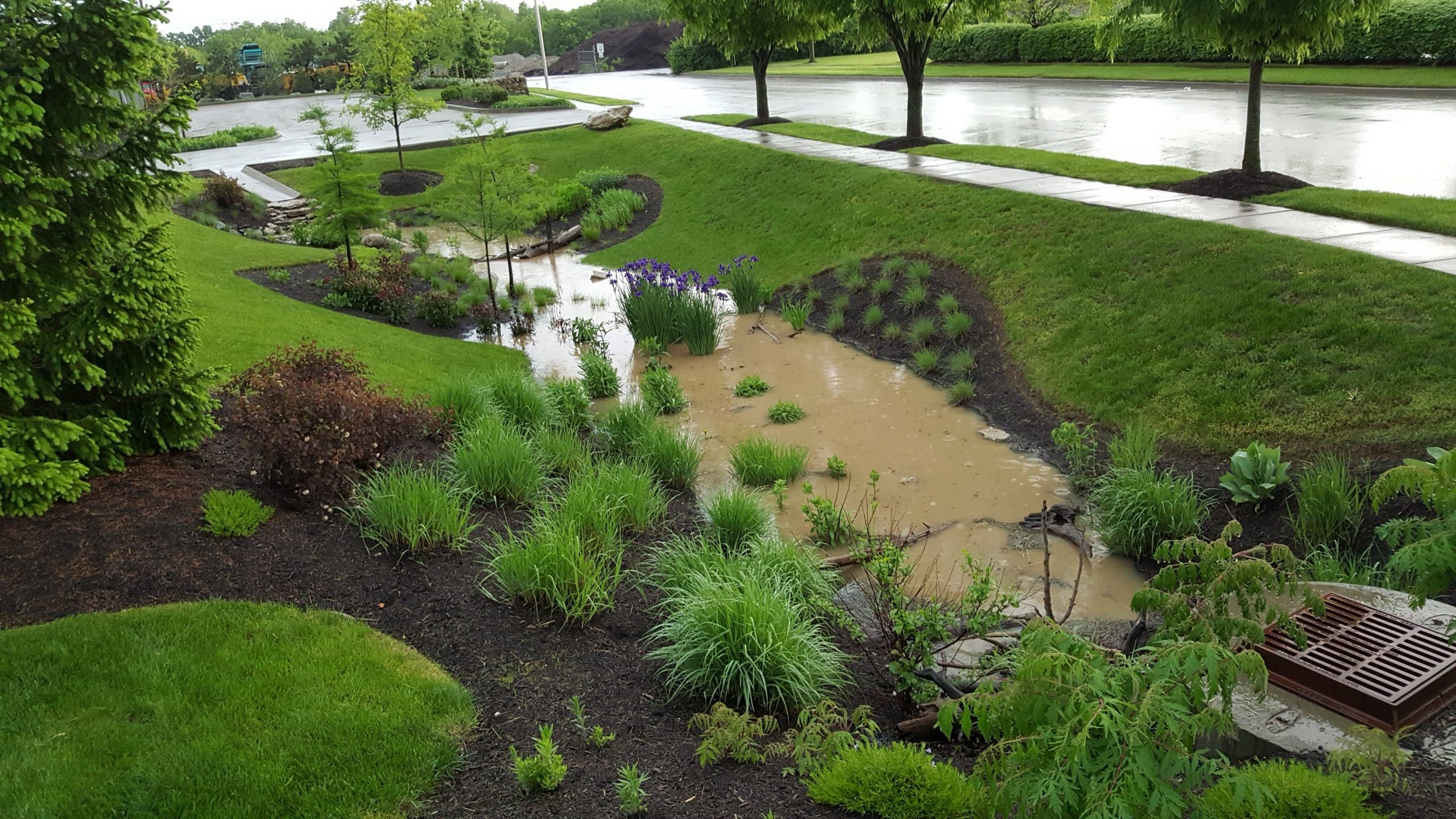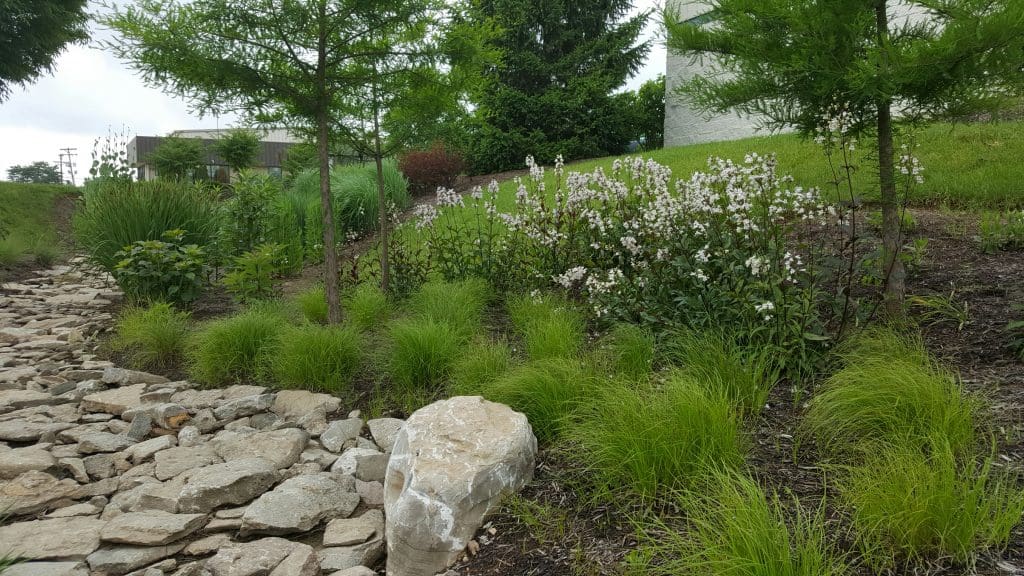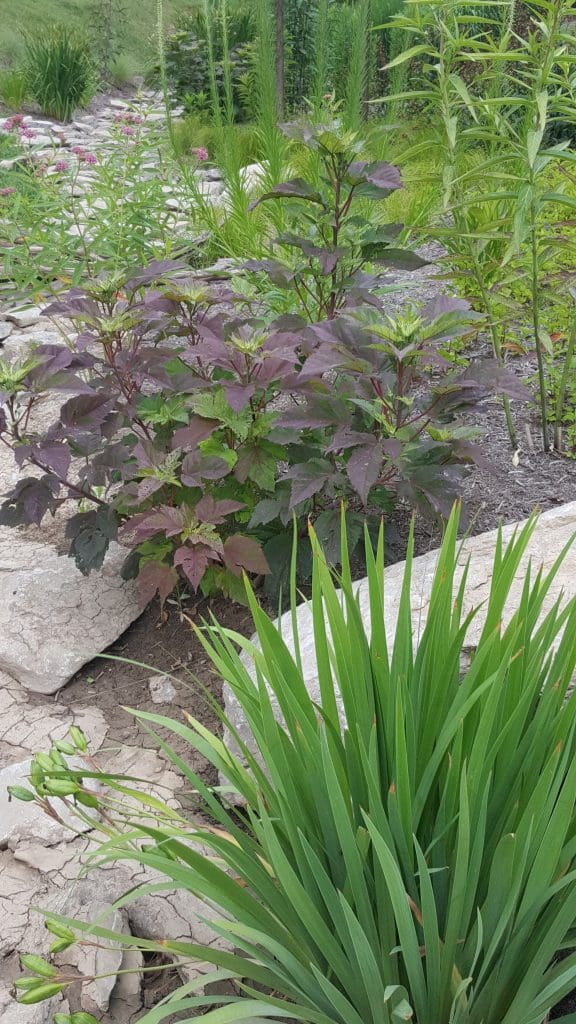
There are many facets to sustainable landscape practices and one aspect is effective stormwater management. If left unmanaged, stormwater runoff can result in flooding around a property and runoff picking up contaminants that ultimately negatively impact a receiving body of water. One method of stormwater management is the installation of bioswales on a property.
“Bioswales are another piece we can offer to help our clients be better stewards of the environment they pay us to maintain,” says John Backert, account manager for The Klausing Group, based in Lexington, Kentucky. “We want to sell more than just traditional landscaping; we want to offer solutions.”
What Is a Bioswale?
If you’ve been around in the industry for any length of time, you’ve probably heard the term bioswale, but you may not be quite clear on what makes something a bioswale.
“A bioswale is a curved channel carved into the land that is used to collect and convey stormwater runoff from roads, roofs and parking lots,” says Robin Anglemyer, a CBLP certified landscape designer for Strauser Nature’s Helpers, based in Stroudsburg, Pennsylvania. “They are typically designed to mimic natural hydrology. Their purpose is to filter pollutants from the stormwater, recharge the groundwater table, as well as prevent erosion due to high volume flow.”

It is also important to understand that bioswales and rain gardens are not synonymous, so the two terms should not be used interchangeably.
“The major difference between a rain garden and a bioswale is that bioswales are conveyor systems, they slow and direct moving water allowing some of it to infiltrate,” Backert says. “Bioswales then direct the excess stormwater into an existing drainage or storm system.”
Backert explains that rain gardens are meant to increase infiltration and do not have an outlet to convey the runoff outside the garden’s borders.
Bioswales are best suited to near roofs, roads, parking lots and driveways, where they can catch and direct stormwater coming off hard surfaces.
“Slopes with gradual grade changes work best, however, check dams can be added to aid in slowing the water down and decreasing slope erosion and channel cuts in areas with steeper slopes,” Anglemyer says.
Brandon Gepper, LIC, director of construction operations with Environmental Management, Inc. based in Plain City, Ohio, adds that bioswales can add a lot of color to urban districts and are often more appealing than stormwater detention basins.
Dispelling the Myths
If your clients have hesitations about installing a bioswale, take the time to clear up some of the misconceptions about them.
One common belief is that bioswales are unattractive or unkempt. However, if a bioswale is properly designed and maintained it can be extremely beautiful. Backert says that bioswales by their design are informal so educating clients about the seasonal changes and discussing their expectations can go a long way.
Some may think bioswales just look like a weedy drainage ditch, and this is why plant selection is key. Backert advises using plant material that has contrasting foliage texture along with a variety of heights and seasonal interest. It’s also necessary to properly maintain them.
“Bioswales are not no maintenance options for stormwater management,” Anglemyer says. “In fact, there are routine maintenance practices that will aid in the long-term function of the bioswale.”
Another fallacy is that bioswales are breeding grounds for mosquitoes.
“Mosquitoes need water to stand for 7 to 12 days to lay and hatch eggs,” Backert says. “Any standing water in a bioswale usually will last for only a few hours after storms, so this is not really an issue.”
Anglemyer adds that bioswales are designed to be dry, aside from the periods right after rain events.
Proper Installation Practices
If you want to start installing bioswales, it’s crucial you educate yourself on the design and mechanics of bioswales.
“There are particular soil types and plant types that will work in bioswales,” Gepper says. “If done improperly they will turn into an unsightly swamp or barren desert. Many local universities have classes on proper installation and maintenance of bioswales.”
Anglemyer says there are a number of classes and programs designed to certify and educate landscape professionals on green infrastructure and sustainable stormwater solutions and best practices.
“Programs such as the Chesapeake Bay Landscape Professional certification (CBLP), as well as Penn State Master Watershed Steward are available to professionals who would like to learn how to design, install, and maintain sustainable landscapes,” Anglemyer says.
Some of the installation components include checking with local agencies that manage storm sewers and waterways as the regulations can vary and ensuring the soil infiltration rate is half an inch per hour or greater. Gepper says underdrains may be necessary to deal with long periods of rain where the soil is very clay-like.
“As a rule of thumb, the size of the swale should be at least one percent the size of the area draining to it,” Backert says. “The larger the swale, the more storage and infiltration of stormwater. When designing a swale, it is important to consider where water will move to during very large rainfalls. A high flow bypass or overflow outlet is needed to convey large stormwater events.”
The groundwater level should not reach the bottom of the swale, and contrary to popular belief, a bioswale should not be sited in an actual wet area. Bioswales should be constructed with slopes of 5 percent or less.
“Slopes ranging from 1 percent to 4 percent are ideal and at a 4 percent slope check dams are recommended to increase water retention and infiltration, as well as to control slope erosion,” Anglemyer says.

As for the type of plants that should be used in a bioswale, they will vary based on where you are located but should be native species that grow in natural drainage areas.
“Native plants have deeper root systems and are better able to control stormwater flow, increase water infiltration and filter pollutants than standard turfgrass and non-native plants and stone itself,” Anglemyer says. “Native plants also provide the added benefit of pollinator value and wildlife habitat introduction.”
Backert says you should look for thick growing grasses and plants with dense, deep root systems as the thicker the vegetation, the more effective it will be at slowing the water and preventing erosion within the swale. He says these plants will need to tolerate both very wet and very dry conditions.
Gepper adds that these plants should be low-maintenance and thrive in full sun. Grasses, sedges and flowering perennials all make great bioswale plants.
It’s important to remember that bioswales are not appropriate for all places, namely locations with very flat grades where the water can’t flow or steep sites where the flow rate may exceed 5 cubic feet per second.
“Bioswales are not suitable in locations with low infiltration rates and high-water tables,” Backert says. “We want to provide an area where water can be absorbed. We don’t want it to sit and pond.”
Anglemyer adds while bioswales filter pollutants, they should not be installed nears “hotspots” like gas stations, as the high concentrations of pollutants may be transferred more readily to the groundwater.
Benefits of Bioswales and Why They Should Be More Common
Bioswales feature a number of environmental benefits including:
- Increased water quality in nearby streams, rivers and lakes.
- Reduced the demand on stormwater systems.
- Recharged groundwater levels by allowing the water to leach into the surrounding subgrade.
- Reduced erosion in nearby streams and rivers by slowing water down before entering the water system.
- Reduced wear on local stormwater systems due to less frequent use.
“Beyond the many environmental advantages, installing bioswales is a vital component of smart landscaping,” Backert says. “By using our resources wisely, we can set a higher standard. We can provide our clients with landscape solutions that are better for their bottom line, their community and the environment.”
Anglemyer adds that bioswales are usually less expensive than standard underground storm sewer solutions and curb and gutter systems.
“As 100-year storms and flooding become more frequent, green infrastructure, such as bioswales and rain gardens help relieve the burden on our already overloaded traditional stormwater systems,” Anglemyer says. “Traditional stormwater solutions generally divert stormwater, moving water issues downstream or to the downhill neighbors. Green infrastructure and bioswales allow water to be dealt with on site without passing the problem on.”
“Anyone that cares about the quality of local waterways should champion the installation of bioswales,” Gepper says. “Landscapers should also use them as a sales tool. Public perception on water quality is a big deal and a service provider that is cognizant of that can use bioswales as a sales tool.”
This article was published in the January/February issue of the magazine. To read more stories from The Edge magazine, click here to subscribe to the digital edition.

